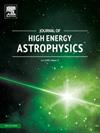Black holes immersed in polytropic scalar field gas
IF 10.5
4区 物理与天体物理
Q1 ASTRONOMY & ASTROPHYSICS
引用次数: 0
Abstract
By implementing the concept of polytropic structures as a scalar field gas with a dark energy-like behavior, we obtain a static spherically symmetric black hole solution in the framework of general relativity. In this paper, we study the quasinormal modes, the greybody bound process, the shadow behaviors, and the sparsity of black holes with a surrounding polytropic scalar field gas. Using the Wentzel-Kramers-Brillouin (WKB) approach, we evaluate the impact of a particular set of polytropic parameters with a fixed setting of the polytropic index n on the oscillation frequency and damping rate of gravitational waves. The results show that the effect of the parameter ξ is much less significant than that of the parameter A on the gravitational waves oscillation frequency and damping rate. Furthermore, the analysis of the greybody factor bounds reveals special insight into the effect of certain parameters where the multipole moments l and the polytropic index n have similar effects, in contrast to the pair of polytropic parameters (). In light of such a comparative study, we investigate, on the other hand, the third-order Padé WKB method, which results in a more accurate process for quasinormal mode frequencies compared to the third-order standard WKB method. In this way, exploring the sparsity of Hawking radiation is another task that provides a better understanding of the behavior of the black hole solution. In this respect, the results show that the black hole behaves like blackbody radiation for a sufficiently large entropy. And for , the relevant sparsity acts exactly like the Schwarzschild sparsity. These results provide an insight into the dynamics of black holes with a surrounding polytropic scalar field gas from the analysis of their quasinormal modes, greybody factors, shadow behaviors, energy emission rate and sparsity process. Constraints on the associated BH parameters, derived from the Event Horizon Telescope observations of M87* and Sgr A*, indicate that this black hole model stands as a compelling candidate for representing astrophysical black holes.
沉浸在多向标量场气体中的黑洞
通过将多向性结构的概念实现为具有类暗能量行为的标量场气体,我们得到了广义相对论框架下的静态球对称黑洞解。本文研究了围绕多向标量场气体的黑洞的拟正态模式、灰体束缚过程、阴影行为和稀疏性。利用WKB方法,我们评估了一组特定的多向性参数(ξ, a)对引力波振荡频率和阻尼率的影响,该参数具有固定的多向性指数n。结果表明,参数ξ对引力波振荡频率和阻尼率的影响远小于参数A。此外,对灰体因子界的分析揭示了对某些参数的影响的特殊见解,其中多极矩l和多向性指数n具有类似的影响,而不是对多向性参数(ξ,A)。基于这样的对比研究,我们研究了三阶pad WKB方法,该方法与三阶标准WKB方法相比,对拟正态模态频率的处理更加精确。通过这种方式,探索霍金辐射的稀疏性是另一项任务,可以更好地理解黑洞解的行为。在这方面,结果表明黑洞在足够大的熵下表现得像黑体辐射。对于ξ=A=0,相关的稀疏性和史瓦西稀疏性完全一样。这些结果从黑洞的准正态模式、灰体因子、阴影行为、能量发射率和稀疏性过程等方面提供了对黑洞周围多向标量场气体的动力学分析。从事件视界望远镜对M87*和Sgr A*的观测中得出的相关黑洞参数的约束表明,这个黑洞模型是一个令人信服的代表天体物理学黑洞的候选者。
本文章由计算机程序翻译,如有差异,请以英文原文为准。
求助全文
约1分钟内获得全文
求助全文
来源期刊

Journal of High Energy Astrophysics
Earth and Planetary Sciences-Space and Planetary Science
CiteScore
9.70
自引率
5.30%
发文量
38
审稿时长
65 days
期刊介绍:
The journal welcomes manuscripts on theoretical models, simulations, and observations of highly energetic astrophysical objects both in our Galaxy and beyond. Among those, black holes at all scales, neutron stars, pulsars and their nebula, binaries, novae and supernovae, their remnants, active galaxies, and clusters are just a few examples. The journal will consider research across the whole electromagnetic spectrum, as well as research using various messengers, such as gravitational waves or neutrinos. Effects of high-energy phenomena on cosmology and star-formation, results from dedicated surveys expanding the knowledge of extreme environments, and astrophysical implications of dark matter are also welcomed topics.
 求助内容:
求助内容: 应助结果提醒方式:
应助结果提醒方式:


